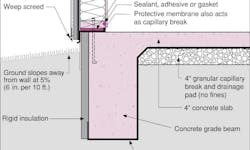Slab Edge Insulation: Why it Matters
You can't stop heat flow, but you can keep your floor becoming a big ol' heat sink
Slab edge insulation keeps heat in or out of a house, depending on the climate and the season. A slab can be insulated with rigid foam, mineral wool, or other rigid insulation rated for below-grade use. The above-grade insulation needs to be protected from UV radiation and impact damage.
Physics 101: Heat flows from warm to cold
Concrete is an excellent conductor of heat, which means that it is a poor insulator. Heat flows from hot to cold, so in winter it flows one way (out of the house), and in summer it flows the other (into the house).
The temperature difference between inside and out dictates the intensity of the heat flow. An outside temperature of 100 degrees and an inside temperature of 75 means the temperature difference is 25 degrees. An outside temperature of 0 degrees F and an inside temperature of 70 means the temperature difference is 70 degrees.
Heat flow is more intense in a cold climate during winter than in a hot climate during summer.
The exposed perimeter of a slab is more important than the underside because the ground is generally around 60 degrees, which gives a temperature difference of 15 degrees and 10 degrees respectively for the above examples.
The ground does freeze in cold climates, so it is important to insulate below the frost line or use a frost-protected foundation of some sort.
Heat gain through a slab in hot climates can significantly hinder an AC unit's ability to keep a house comfortable because the heat that flows in stays in the slab. This is like inadvertent radiant floor heating.
Heat loss through a slab in a cold climate house wastes energy and makes a house very uncomfortable—especially for bare feet.
Cold floors can also cause humidity inside a house to condense into liquid water, which can feed the mold machine leading to indoor air quality problems.
How to slow the flow
There are more than a few ways to combat heat flow through a slab, but it boils down to putting insulation over the biggest energy nose bleeds—generally the above-ground perimeter.
Extreme builders seeking Passive House certification put a lot of insulation under slabs, but this is not money well spent on typical homes—even very efficient ones—unless you significantly improve air sealing, attic and wall insulation (~R-100 and R-40 respectively), and boost the windows to triple-glazed R-5 units.
You can use any rigid insulation rated for below-grade use, but most builders and remodelers use extruded polystyrene (XPS) because it is easy to get.
In areas with a lot of termites, you will need to take extra precautions such as borate treatments, termite shields, and inspection gaps.
<code>
2012: IECC:
* SECTION R402 BUILDING THERMAL ENVELOPE
* SECTION R403 SYSTEMS
2015 IECC:
* Section 402: Building Thermal Envelope
* R502.1.1.1: Building Thermal Envelope (existing building)
* R 502.1.1.2 Heating and Cooling Systems (existing building)
</code>
More to explore:
- Building America Solutions Center: Guide to Slab Edge Insulationt
- Measure Guideline: Hybrid Foundation Insulation Retrofits
- Stem Wall and Footing in One Pour
*Image courtesy of Building America Solutions Center
